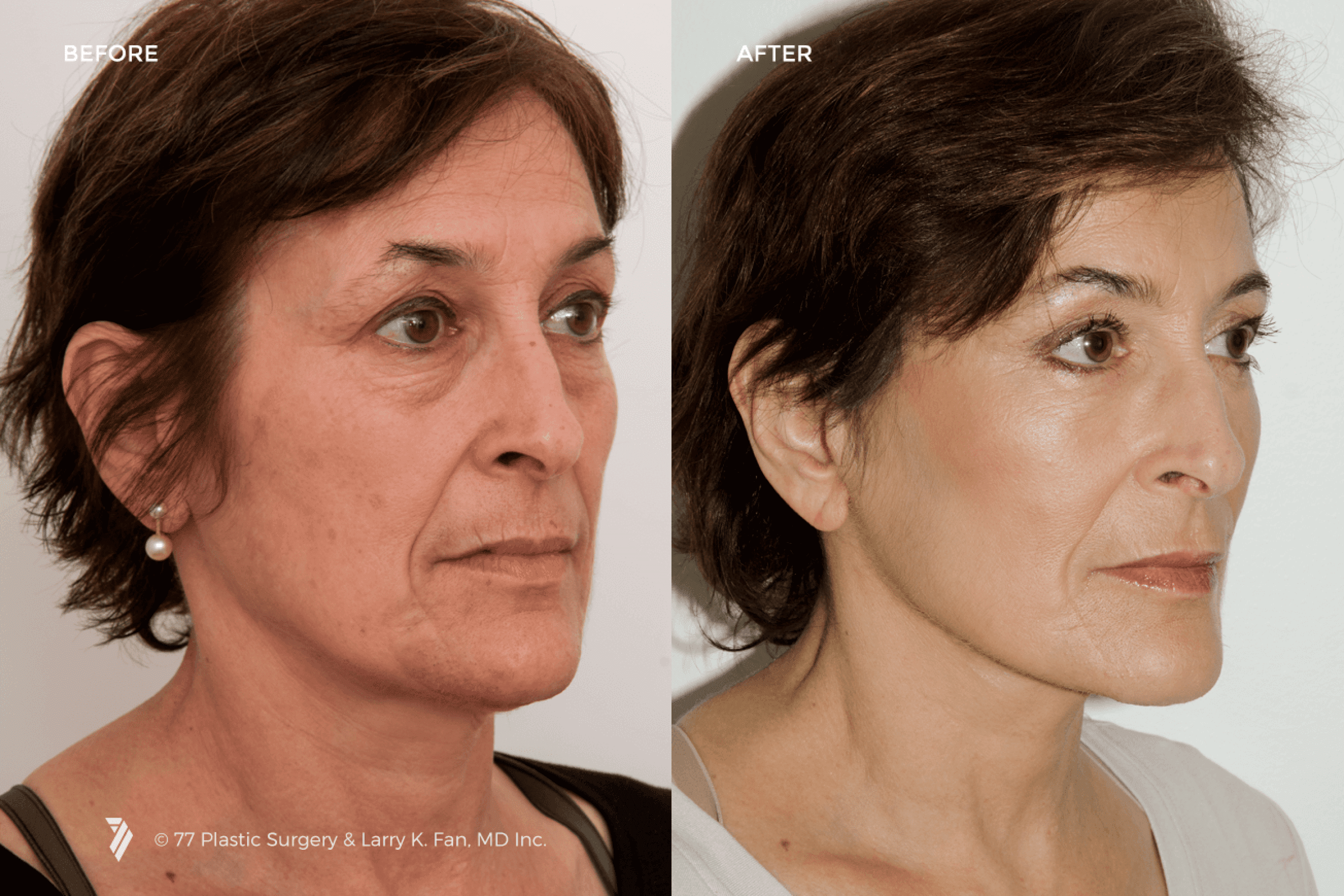Facelift Surgery
When it comes to improving one's appearance, facelift surgery may be the most popular and sought-after cosmetic surgery procedure.
A facelift can help reduce wrinkles, reduce sagging skin, and restore a more youthful and vibrant look. This procedure is not only popular among adults over 40 years old who are looking to reverse the signs of aging, but also with younger patients who want to improve the contours and shape of their face.
Are You A Candidate?
Our Cosmetic Self Evaluation can help you decide if this procedure is right for you:
TAKE OUR SELF EVALUATIONBenefits of Facelift Surgery
Reduced wrinkles and sagging skin.
By removing excess fat, tightening underlying muscles, and redraping the skin, facelifts can help reduce wrinkles and sagging skin around the eyes, cheeks, and jawline.
Improved contours and facial shape.
Facelifts can help create a more aesthetically pleasing facial shape and contours by addressing areas of volume loss or excess fat in the face.
Long-lasting results.
Depending on the patient’s age and health, facelift surgery can provide long-lasting results that can last for several years.
Facelift Surgery
The process for your facelift begins with a consultation with Dr. Fan. During this visit, you will discuss your individual goals and desired results. Dr. Fan will then examine your facial structure and skin type to determine the optimal technique for achieving those results.
Facelift surgery is a highly individualized procedure, and no single technique is appropriate or "best" for all patients. The placement and length of incisions, as well as the specific techniques used, depend on your goals and facial characteristics. Dr. Fan is experienced with various facelift techniques and will choose the right one for your unique situation.
The actual facelift procedure usually takes about four to six hours and involves making small incisions in your skin to access the underlying muscle, fat, and tissue. Dr. Fan will then manipulate these layers before reshaping and pulling your skin back in order to create a more youthful-looking face.
After the surgery is complete, it is important for you to follow the post-operative instructions provided to you to reduce swelling and bruising. The results of a facelift can often last for several years, depending on your age and health.
Am I a candidate for a facelift?
If you are bothered by visible signs of facial aging and have realistic expectations, you may be a suitable candidate. Good overall health and being a non-smoker are also important factors.
Recovery
Recovery after a facelift typically takes two to three weeks. You may experience swelling and bruising during the healing process, which can cause temporary discomfort. It is recommended to rest and receive assistance for the first 3–5 days after surgery. Return to work is usually expected within 2–3 weeks, but it may take a few months to feel completely back to normal. Dr. Fan and his team will guide you through the recovery process, ensuring your comfort and successful healing.
Facelift Surgery in San Francisco, CA
Facelift surgery can be an effective option for those looking to reduce wrinkles, sagging or excess skin, and other signs of aging. By tightening underlying muscles and redraping the skin, patients can achieve a more youthful-looking appearance that may last for several years. Dr. Fan is an experienced plastic surgeon who can help you achieve your aesthetic goals. We encourage you to schedule a consultation at our practice to see how we can help.
Frequently Asked Questions
1. Should I consider a facelift in San Francisco?
If you are bothered by visible signs of facial aging and have realistic expectations, a facelift in San Francisco may be a suitable option for you.
2. How is a facelift performed?
A facelift involves anesthesia, lifting of the skin and underlying support tissues, and fat contouring. The skin is lifted through incisions starting in the temple and circling in front of the ear.
3. How much does a facelift cost in San Francisco?
The cost of a facelift can vary depending on factors such as patient needs, procedure type, surgeon's experience, and location. We will provide a cost estimate during your consultation.
4. How do I know if I'm ready for a facelift?
If you are bothered by visible signs of facial aging and have realistic expectations, you may be ready for a facelift. Consult with a qualified plastic surgeon like Dr. Fan to determine if it is the right procedure for you.
5. Can non-surgical treatments deliver the same results as a facelift?
Non-surgical treatments, like BOTOX®, fillers, and laser treatments, can provide temporary improvements, but they cannot deliver the same long-lasting and comprehensive results as a well-executed facelift surgery.
6. How long will my facelift results last?
The results of a facelift can be long-lasting, but the aging process will continue. Factors such as genetics, lifestyle, and sun exposure can affect the longevity of the results. Touch-up procedures may be recommended to maintain a youthful appearance as you age.
Facelift Surgery
Success Gallery
SEE OUR BEFORE & AFTERS
Live outside of
the Bay Area?
Give us a call and ask about our fly-in program. A world class experience tailored for you.
LEARN MOREWant to see your after photos before you start the procedure?
Ask us about our 4D simulation technology.
Learn MoreExperience The Fan Method™
At 77 Plastic Surgery, Dr. Fan uses The Fan Method to provide safer surgery and superior results. If you're ready to transform your appearance and boost your confidence, look no further than 77 Plastic Surgery in San Francisco. Led by renowned plastic surgeon Dr. Larry Fan, our practice is dedicated to providing elite plastic surgery and aesthetic services. With a focus on stunning natural results and safe, proven treatments, Dr. Fan is recognized as one of America's top plastic surgeons. Join the #FANClub and begin your journey toward a more confident and beautiful you. Learn more about our practice and the services we offer.





